LONGTIME SEATTLE TRACK OPERATOR ROCKSTAD, 79, REMEMBERED AS TESTED-BUT-TENACIOUS ASSET TO NORTHWEST RACING
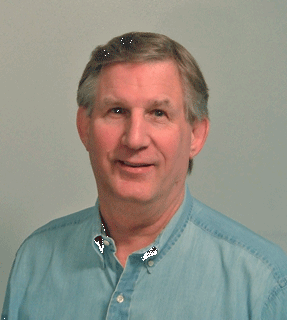 John Force wasn’t always a drag-racing superstar. Sometimes, by his own admission, he wasn’t much of a drag racer at all. And he might not have been one for long had it not been for Jim Rockstad.
John Force wasn’t always a drag-racing superstar. Sometimes, by his own admission, he wasn’t much of a drag racer at all. And he might not have been one for long had it not been for Jim Rockstad.
Rockstad, who passed away late Monday, June 13, at age 79 following an extended illness, leased and operated Seattle International Raceway (“SIR,” its name before it reverted to Pacific Raceways in 2001) for about a quarter of a century. And not long into his tenure, a young John Force reached a crossroad in his career, one he brought on himself.
“We ran St. Louis on a Wednesday night. We had to be in Seattle on Saturday, which meant I had to be there Friday,” Force said. “I drove my own 18-wheeler. We lived in the truck, my brother Louie and Bob Fisher and me. The night I left St. Louis, I ripped down one of his light poles going out the door with the 18-wheeler. The guy ran out there, and he said, ‘Are you nuts? You ripped down our pole!’ I said, ‘You know, it’s two in the morning. We’ve got to be in Seattle, and it’s clear across the country and I’ve got to go.’ So we took off for Seattle, and I drove around the clock. I was always trying to prove to Louie and Fisher that I’m the best truck driver – and I’m not.
“When I rolled into the track at Seattle, Rockstad was standing at the gate. This is a true story,” Force said. “He walked over to the truck and he goes, ‘Hey, you’re a little bit early. No one thought you would make it from St. Louis. Ohmygod – what is wrong with your eyes? Your eyes are swollen – you look like you’re dying. Are you OK? You don’t look good, kid.’ He didn’t even know me, just a dumb kid from California.” Force told him, “Aw, I just trucked for days. I can do this. I’m tough.” [Today he will say, “I was stupid.”]
Force said, “What happened from driving is my eyes swelled up, and they were almost closed. And Louie and Fisher were mad at me: ‘You’re going to drive till you kill yourself!’ I was nuts in those days. I was young; I was 20-somethin’. So Rockstad took me out of the cab of the truck at the gate – I don’t even know what he was doing out there – and he put me in one of his guys’ cars and he and this guy drove me to the hospital and told the emergency-room staff, ‘This guy’s had no sleep. His eyes are dead.’ And they fixed me up.
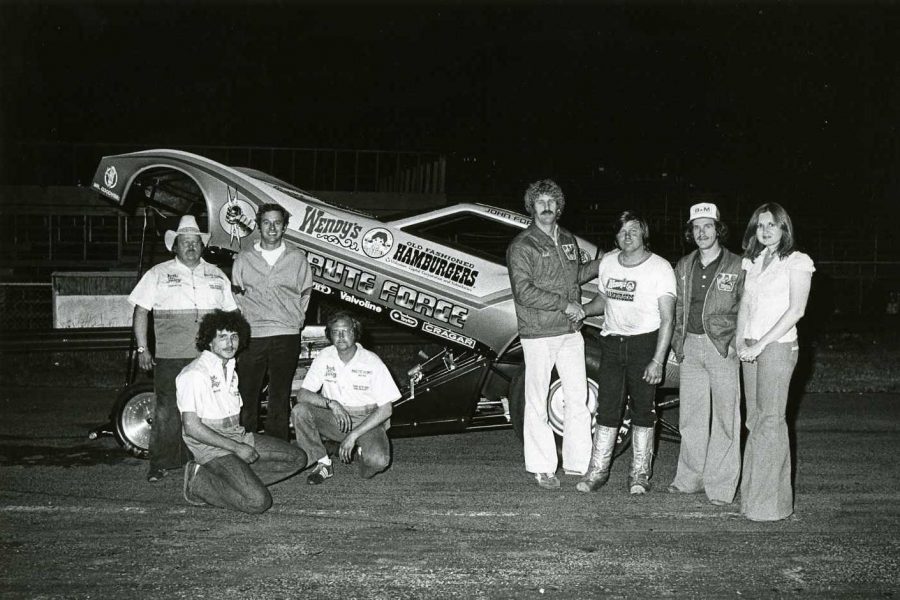 “I came back to the track and ran the race on Saturday. Whatever happened I don’t remember – Prudhomme probably beat me up again, him and McEwen, which they did every week,” Force said. “But that’s the kind of guy Rockstad was. Big, tall guy – should have been a basketball player. Maybe he was. But over the years, he was always there for me, and I always gave him the heart. When he called me and said, ‘I need a radio thing at two in the morning, I did it because he was just a guy that cared about me personally.”
“I came back to the track and ran the race on Saturday. Whatever happened I don’t remember – Prudhomme probably beat me up again, him and McEwen, which they did every week,” Force said. “But that’s the kind of guy Rockstad was. Big, tall guy – should have been a basketball player. Maybe he was. But over the years, he was always there for me, and I always gave him the heart. When he called me and said, ‘I need a radio thing at two in the morning, I did it because he was just a guy that cared about me personally.”
And when Force learned of Rockstad’s declining health, he was touched. Force said, “He matters to me.”
Everyone mattered to Rockstad. After his retirement from drag racing, he became involved with Seattle's Union Gospel Mission, in his words, “using my Lord-given gift of promotional skills to assist in some fundraising, to serve meals to the poor, and an annual men's warm clothing drive for the homeless. I believe that my Savior, Jesus Christ wants me to do that. It's the least I can do for Him. Finding and accepting God's love was the best thing that has ever happened in my life.”
The Seattle Union Gospel Mission serves Washington State’s King County and addresses hunger, homelessness, poverty, addiction, and the needs of high-risk youth, offering stability, mentorship, and character development.
Rockstad wrote in his book, “Rocky’s Road” (Dorrance Publishing, 2018, 181 pages), “I thank the Good Lord all the time for everything that has taken place in my life — both good and seemingly (at the time) bad. The bad times made me a better person to deal with even bigger problems when they came along . . . and they do, most certainly, come along.”
Of his business and personal success, he said, “I owe all of this to Jesus Christ, as he changed my heart, guided and directed me to great heights, and brought me the love of my life, Mo.”
Rockstad is survived by wife Mo; daughter Maren Kreun and her husband, Jesse; and son Zach Rockstad.
“It's hard to understand exactly what 'changing of the heart' means, but accepting Christ not only changes the relationships that you have, but also redirects or guides you into a whole new purpose for your life,” Rockstad said. “You have the desire to approach things in a completely different way—a way that has so much more meaning.”
ROCKSTAD IMPRESSED A SUCCESSION OF DIVISION DIRECTORS
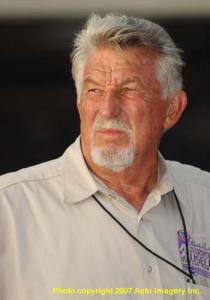 Steve Gibbs, the former NHRA director of competition (and a founder of the California Hot Rod Reunion at Baskersfield), remembered Rockstad as a cooperative colleague: “Rockstad was a good guy. I enjoyed working with him those years at the Seattle race. We had a good relationship.”
Steve Gibbs, the former NHRA director of competition (and a founder of the California Hot Rod Reunion at Baskersfield), remembered Rockstad as a cooperative colleague: “Rockstad was a good guy. I enjoyed working with him those years at the Seattle race. We had a good relationship.”
Former Division 6 Director Gordie Hawthorne spent about two weeks advancing the national event, which involved hours upon hours of physical labor to make sure the facility was safe for the racers and fans. And he still shakes his head fondly at the memories of his conversations at SIR with Rockstad that went something like this:
“Jim, I see something we need to do, and it needs to be done a certain way.”
“No, I don’t want it done that way.”
“Jim, we have to do it this way. The underwriting guidelines say we have to do it this way,”
“I don’t care. If you want it done that way, then you do it.”
“OK, Jim, that’s all I wanted to hear.”
With a laugh, Hawthorne said, “I’d leave with a smile on my face, and he’d look at me and say, ‘Get out of here – and don’t come back until dinnertime.’ All track operators are like that. They like to be in control. But when the NHRA comes in, they take over the track. Rockstad was a good guy. He really was. He knew what he was doing.”
Rockstad then worked with Chris Blair as the Division 6 Director.
“When I first landed in the Northwest Division in 1997, Jim was the go-to guy on the history of racing in the region. He had seen it all and he had done it all. From big spectaculars to weekly bracket shows, he knew how to make them work. He provided consistent programming at both Portland and Seattle at the time and did what he had to do to protect the sport in the region,” Blair said.
“We butted heads a few times while I was the Northwest Director, but Jim taught me a lot of valuable lessons in how this business works. My last day as an employee of NHRA was at Jim’s last show, the NHRA Northwest Nationals. Looking back, that was a very special day.”
 Of course, Rockstad – like every track operator, but more profoundly so because he did business in the Pacific Northwest – had to contend with the weather, that monster threatening all outdoor-event organizers. And current venue President Jason Fiorito said he can sympathize with Rockstad for the almost weekly decisions he faced.
Of course, Rockstad – like every track operator, but more profoundly so because he did business in the Pacific Northwest – had to contend with the weather, that monster threatening all outdoor-event organizers. And current venue President Jason Fiorito said he can sympathize with Rockstad for the almost weekly decisions he faced.
“I mean, it’s the adage: What do you call a day of sun after two days of rain in the Pacific Northwest? Monday,” Fiorito said.
If only soggy weather were Rockstad’s only problem, his life would have been much less stressful. Unfortunately, that wasn’t the case.
Blair said, “I never thought Jim got the recognition and respect in the racing community at that last race that he deserved. No matter if you are a Top Fuel racer or a local bracket racer, the reason there’s still drag racing in both Seattle and Portland is because of Jim. I attended county meetings with him where he had to endure badgering from everyone from lawyers to politicians. He was stubborn. He fought for his business. He fought for his racers. He fought for the sport. A lot of track operators would have walked away. Jim stayed in the gas.
“He faced a lot of odds just in keeping the doors open as he had to work around restrictive curfews and neighbors who moved next door and then complained about the noise of a racetrack. Since he only had a lease on the property,” Blair said, “he had to jump over a lot of hurdles and patch things together where others would have given up. He did an amazing job to get to the finish line and was happy when he retired in 2001.
“At the time, Jim probably didn’t realize that his timing was perfect. The 2001 season saw the end of the Winston series sponsorship, and the drag racing promotional business hasn’t been the same since. I think Jim realized that and decided that fighting to keep his track in the face of a changing sponsorship business model would be much tougher than before. He was right.”
No one knows that better than current track operator Jason Fiorito, who said he has come to appreciate his predecessor Rockstad, whom once he considered a nemesis rather than caretaker of his family’s legacy.
“Jim, if nothing else, had a lot of ‘stick-to-it-iveness.’ He had some sand in his shoes, and he endured some pretty tough years there. And he was out there on his own,” Fiorito said. “I know how tough it is to keep a track alive, but I have a lot of resources behind me. Thank goodness my dad has always backed me and allowed me to rob from other family businesses that were doing well to keep the gates open. And Jim didn’t have the resources I have. So, I have to genuinely have respect for a guy who kept the track alive for a few decades without any support behind him.
“He gave me the opportunity to pick up the ball and try to do as well as I can with it,” he said. “If nothing else, I respect the fact that he was in an industry that’s a pretty tough industry and kept it going and kept drag-racing alive and even maintained the road course in condition that it was salvageable by the time I got there.
“At the end of the day, I didn’t agree with everything he did. As somebody who’s been out there for 22 years now, I understand some of the rocks and hard places he was in between,” Fiorito said. “Sometimes being up against it forces you to do things that you wouldn’t ordinarily think were a good idea. I know Jim did things that maybe at the end of the day even he wasn’t proud of, but it was out of necessity.
“We’re all emotionally invested when we’re out there in what goes on and the product we’re providing. Sometimes the economics of the events warrant what we’re doing, and sometimes they don’t. But we do it because we love the track, and we do it because we love the people out there. Sometimes not every decision is a business decision. At the end of the day, Jim had to survive without any big horsepower behind him,” Fiorito said.
“I know what it takes to keep that place alive, and sometimes it takes some pretty substantial horsepower. And if I didn’t have that behind me, I probably would have made some of the same decisions Jim had to make along the way. He just didn’t have the backing I have. I’m grateful for the backing I have, and I also respect Jim for doing what he did for two and a half decades out there,” Fiorito said. “I don’t have to agree with all of it, but I have respect for him.
“He’s part of the fabric of the racing community in the Pacific Northwest. He was on his own there and kept the place open for over two decades,” he said. “He gave me the opportunity to take over where he left off by keeping it alive for long enough that I got my chance at bat.”
 Scott New, the second-generation operator at Firebird Raceway near Boise (Eagle, Idaho) along with his brothers Brad and John, said, “We got to live through the entire heyday of SIR and PIR [Portland International Raceway, which Rockstad also operated for many years] all the way to the tail end when he stepped away from the sport.” And he said, “Jim was true survivor and did whatever it took to avoid losing the whole business. Jim was in the right place at the right time.”
Scott New, the second-generation operator at Firebird Raceway near Boise (Eagle, Idaho) along with his brothers Brad and John, said, “We got to live through the entire heyday of SIR and PIR [Portland International Raceway, which Rockstad also operated for many years] all the way to the tail end when he stepped away from the sport.” And he said, “Jim was true survivor and did whatever it took to avoid losing the whole business. Jim was in the right place at the right time.”
Rockstad presided over the Seattle racetrack [and Portland International Raceway] in the memorable Bill Doner and post-Doner years. For Rockstad, the charisma and exuberance of drag racing dissolved into dealing with what he called “attorneys and contracts, take-it-or-leave-it kind of stuff” and “one bad move after another.” He managed to navigate with poise the transitions from the era of swashbuckling and outlandishness to the era of professionalism to the current era of regulation. Eventually, Rockstad joked in 2021, as his tenure came to a close, that he "has been down the pike too many times" and said he was ready to pull over to the shoulder.
Former track and then NHRA starter Mike Gittings said, “For many years, Jim had the lease during the height of its popularity. Coupled with super-promoter Bill Doner, it was the place to be. Some of the best races ever (Fox Hunts, 64 Funny Cars, motorcycle stunt jumpers – including a wood stage built over the staging lane – and at the end of a large race, a rock band played and everyone danced all the way down the track. Jim also had the foresight to hire great people, like Russell Stevenson as drag manager, for many years. The place was electric.”
Fiorito recognized that: “Bill Doner was a hell of a promoter. And Rockstad was his protégé. And Rockstad ran some events that were very successful over the years and brought in a lot of people.”
However, the culture of drag racing and of American society shifted during Rockstad’s reign, and those manic types of events no longer worked, no longer whipped the masses into a frenzy.
Force said he didn’t think that was a negative thing: “When I first came to Seattle – 100 years ago – I came for Bill Doner. I raced 64 Funny Cars – rock bands, people all over the track, people streaking the track, the crazy days. Then Rockstad came along in that era, but he brought a lot of normal to it. The guy was very smart. He knew what people wanted. They wanted to race. They liked music, but they didn’t want a rock concert. They wanted drag racin’. And that’s what I loved about him.”
Current Division 7 Director Mike Rice grew up at Seattle International Raceway alongside dad Ray Rice, the Northwest’s chief starter in the 1970s and ‘80s who retired and yielded the job to Mark Lyle. Mike Rice, who for a short time was the Division 6 boss, started working in the office at SIR and saw the business and sometimes playful side of Rockstad.
“He was always good. He was always a straight shooter. He was such a nice guy. He was all-business all the time. He did play racquetball two to three times a week and was tournament player. But I can remember sitting in the office, with him fretting over what the weather was going to do [that] weekend. That’s a constant battle for any track operator. He worried about the business end of it and made sure the racers got paid and made sure the gate was coming in right. He was just a good guy,” Rice said.
“There was always the Big Three in the Northwest: the Livingstons [at Woodburn, Ore.], the News [at Boise], and Jim Rockstad. Those were the guys you went to for advice. They were the guys that made it all happen up there. I became the division director in 2001, and in the short time I was there, I was happy I got to put him in the Hall of Fame up there.”
RACING COMMUNITY REMEMBERS ROCKSTAD FOR HIS KINDNESS
 Scott New said Rockstad “was like a second uncle to me. Jim and my dad, Bill, were like brothers.” Both Bill and Scott New visited throughout the years with Rockstad by phone consistently, “constantly sharing ideas, trying to devise what might be the next best mousetrap, some plan to create something new. The guy was incredibly gifted at storytelling and was a lot of fun to be around.”
Scott New said Rockstad “was like a second uncle to me. Jim and my dad, Bill, were like brothers.” Both Bill and Scott New visited throughout the years with Rockstad by phone consistently, “constantly sharing ideas, trying to devise what might be the next best mousetrap, some plan to create something new. The guy was incredibly gifted at storytelling and was a lot of fun to be around.”
He said, “I always thought of Jim much more as a promoter versus a track operator. He just loved to come up with inventive ideas and new events and was never bashful or timid about experimenting with this or that to develop SIR into the track that it became.”
Scott New was 11 years old when he first met Rockstad, exactly 50 years ago. It was in 1972, when his dad took him to Seattle to see the Donor-Rockstad extravaganza that was 32 Funny Cars, the precursor to the epic 64 Funny Cars spectacle – to prep for the Nightfire Nationals that has become a legendary Northwest event at Firebird. So New knew: he knew the generosity and the humility of his friend – but also the boldness of the normally understated Rockstad.
New said Rockstad “took the bull by the horns and really was on quite a ride for his entire career.” One of the bumpiest parts of the journey might have come in the 1980s, when Rockstad – in part because of his weather-related frustration with scheduling from the NHRA – broke from the NHRA and aligned himself and SIR with the American Hot Rod Association (AHRA).
“I just think [AHRA boss] Jim Tice had a formula back then, coming off the ’70s, a different set-up than what the NHRA had. Jim had more of a booking format with a purse in place and they would guarantee [the stars of the sport a payout]. From an entertainment perspective, Tice just had his way of doing things that was quite a bit different. He had something, a way about him, that struck the fancy of the true promoters, the barnstorming-type promoters, that existed out there,” New said.
“High-school racing started at PIR in 1975, and I think that was the first high-school racing program in the entire country. Jim was on the ground floor of something that to this day I think is one of the more important things we do in keeping kids or getting kids involved with our sport. That was a real big focus I remember learning from Jim,” New said. “He always worked hard to get faculty members involved and parents, as well. Those races were always big here, but they were three times as big in Seattle.
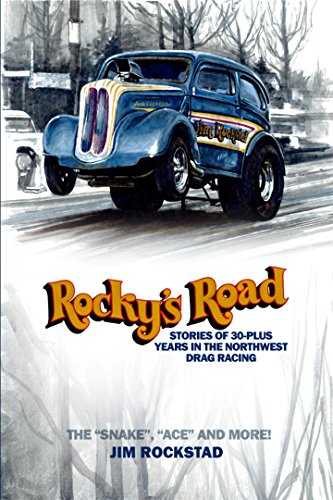 “In ’78 or ’79, at Kent [Wash., home of SIR/Pacific Raceways], Jim [hosted] what would have been the biggest high-school race ever staged.” His recollection is that “1,000 high-school students came to race and 10,000-12,000 people came and packed the place. Therein started the incredible run of high-school races in Seattle. They were beyond epic, in my memory, anyway. He definitely was focused long before Vinny Napp at Englishtown started the Jr. Dragster program.”
“In ’78 or ’79, at Kent [Wash., home of SIR/Pacific Raceways], Jim [hosted] what would have been the biggest high-school race ever staged.” His recollection is that “1,000 high-school students came to race and 10,000-12,000 people came and packed the place. Therein started the incredible run of high-school races in Seattle. They were beyond epic, in my memory, anyway. He definitely was focused long before Vinny Napp at Englishtown started the Jr. Dragster program.”
Rockstad championed New’s ability to announce and convinced Bernie Partridge, the NHRA’s primary announcer from 1958-89, to give New a shot at the mike.
“Jim did so many nice things for us. Jim was such an incredible guy, all the things he did for our family,” New said. Rockstad even bankrolled a loan for Bill New, so he could purchase a strategic parcel of land that remains valuable today as Firebird Raceway’s main spectator parking lot. An earlier time, he lugged two massive World War II-vintage searchlights from Seattle to Boise, in an early-year snowstorm, to help give Bill New a promotional edge for an event there.
But, Scott New said, “Jim, no question, he never wanted to be in the spotlight. You rarely would see him seeking out a winners circle to make sure his picture was included along with [the hero of the moment]. Jim just wasn’t that way. He was very much so a businessman behind the scenes. I don’t know if he ever aspired to get a lot of attention for how creative and inventive and forward-thinking he was. He did things much more behind the scenes, but he left a footprint that was substantial,” he said.
Rockstad was recognized, along with his Northwind Dragster team, and inducted into the NHRA Northwest Hall of Fame in 2013. And New said he thought that was fitting: “Jim was somebody I always thought should be honored in a great way for the legacy that he left within Division 6. He played a huge role in helping move the Northwest Division through the ’70s, ’80s, and ’90s. He was respected by a lot of the independent operators around the country.”
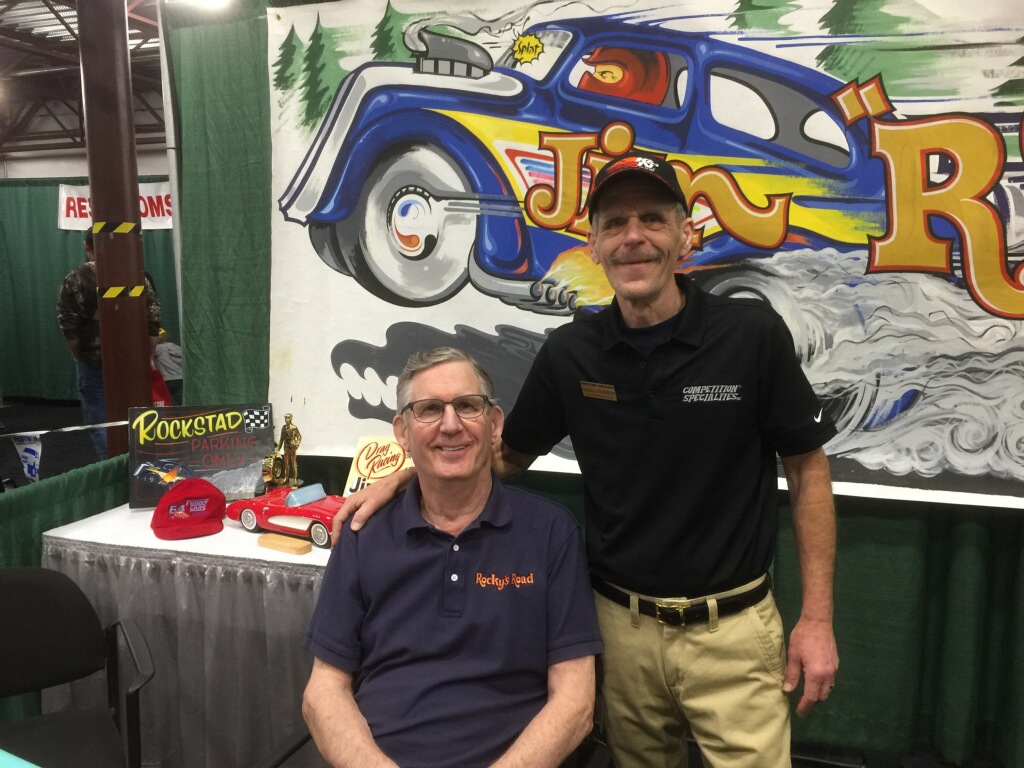 At Doner’s request, dragstrip manager Russell Stevenson went to Portland International Raceway back in the 1970s to help Rockstad put on a race. Rockstad welcomed him with open arms, yet Stevenson was a bit concerned when Doner contracted with Rockstad to manage SIR. Stevenson said he figured Rockstad wouldn’t need him, because he already knew how to prep and run a dragstrip. But Rockstad again welcomed Stevenson and kept him in place, saying Stevenson would oversee track matters while he tended to administrative matters. The partnership worked hand-in-glove, for Stevenson remained with Rockstad for the duration and remained friends ever since.
At Doner’s request, dragstrip manager Russell Stevenson went to Portland International Raceway back in the 1970s to help Rockstad put on a race. Rockstad welcomed him with open arms, yet Stevenson was a bit concerned when Doner contracted with Rockstad to manage SIR. Stevenson said he figured Rockstad wouldn’t need him, because he already knew how to prep and run a dragstrip. But Rockstad again welcomed Stevenson and kept him in place, saying Stevenson would oversee track matters while he tended to administrative matters. The partnership worked hand-in-glove, for Stevenson remained with Rockstad for the duration and remained friends ever since.
One thing that impressed Stevenson was the fact Rockstad sent him to racetracks from Portland to Edmonton, encouraging him to study how other facilities operated. “He brought me along and wanted me to learn as much as I could. I never worked for a better boss. He was the absolute best,” Stevenson said.
Former Top Fuel crew member and current Northwest drag-racing historian Chris “Butch” Horn said he won’t forget the thoughtful gesture from Rockstad and wife Mo when longtime public-relations rep Joe Sherk was inducted into the Kitsap Sports Hall of Fame in Washington State. The Rockstads compiled and bound a book of written salutes from drivers, reporters, photographers, and colleagues and surprised Sherk with it.
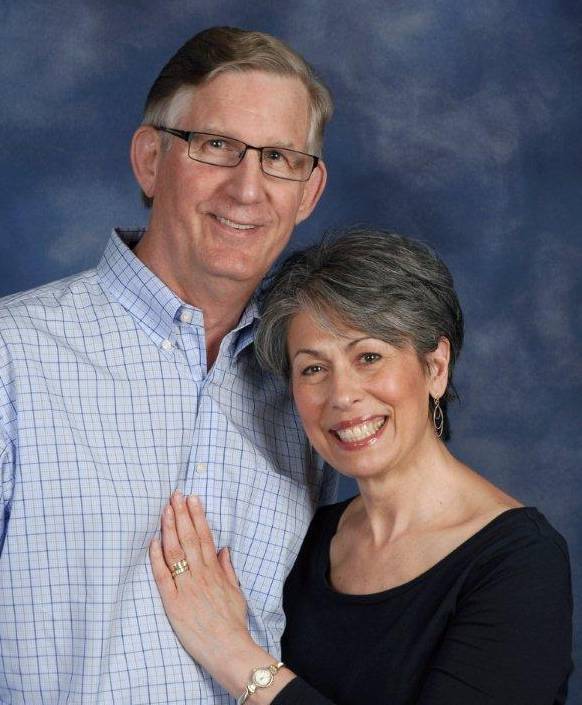 “Joe was just overwhelmed with that book,” Horn said. “It lay on the coffee table for the rest of his life.”
“Joe was just overwhelmed with that book,” Horn said. “It lay on the coffee table for the rest of his life.”
Funny Car driver Bob Gilbertson, whose roots were in the Northwest, fondly recalled the days when he was just a 20-year-old father, sweeping floors at a Portland, Ore., manufacturing plant to pay the $175 monthly mortgage on his 900-square-foot house. He literally would stuff $35 each week into his cooky jar to fund his racing dreams: “I had to go race for Rockstad.”
He said, “Jim had a lot to do with my quest for driving a Funny Car. What stands out is from what I remember, Jim was very grateful for me to always show up to his races at SIR, even when it was raining, all the way there from Portland. I was so happy to get the gas money he gave me! So many memories. Who would think I would go on to win a NHRA event and some runners-up? I was a 22-year-old kid hanging out with Jungle Jim and Raymond Beatle at SIR. But Jim would always take the time to say, ‘Thanks, Kid.’”
Force also recalls a time when he wasn’t sure he would be paid his fee for a grandstand-packed event at Seattle. Rockstad told him, “You didn’t even do a burnout. You do these long burnouts. That’s what Doner said you’re famous for.” Force, who conceded that “That’s all I could do, because I couldn’t beat nobody,” said he thought, “Aw, this guy’s going to screw me. After he took care of me, now he’s going to screw me,” But he replied to Rockstad, “Yeah, my car was screwed up, but I made the run. So I get paid.” Back then, Force said, race promoters judged a driver for the quality of the show he put on for the fans.
“He looked at me,” Force said, “and he said, ‘I don’t understand it. I don’t get how race fans think. You’re the worst driver. Your car’s the worst. You can’t get to half-track without catching on fire. You’re the worst everything. But the fans love you. Look at all the people standing behind you. Is it just because you’re full of s---?’ And I never, ever heard him cuss.
“I said, ‘I live with ’em. I stand at the ropes all day long,” Force told Rockstad. “And Rockstad goes, ‘Yes, you do.’ And he paid me my money.”
Chris Blair said, “I left the Northwest to move to Las Vegas and really doubted that I would see Jim again. However, I ended up having more great conversations with him via e-mail, and each year he would drop in for a visit on his way to and from the Senior Olympics in Southern Utah. Jim would stop by my office at LVMS and share some great stories about the ‘good ol’ days.’
“He made a tremendous, positive impact on the sport of drag racing,” he said. “He will be missed by a lot of us that remember those good ol’ days when the sport was fun.”
Those were the good ol’ days, when Rockstad developed his habit of punctuating notes to his friends with the trademark phrase, “Thunder in the pipes!”
The computer’s spell-check feature constantly offers some amusing alternatives for the name “Rockstad,” such as “Rocksteady” and “Rockstar.”
And in his low-key way, through all of the aggravation and maybe the curse of loving such a difficult-to-deal-with sport as drag racing, ultimately those two words describe perfectly what Jim Rockstad was.






































